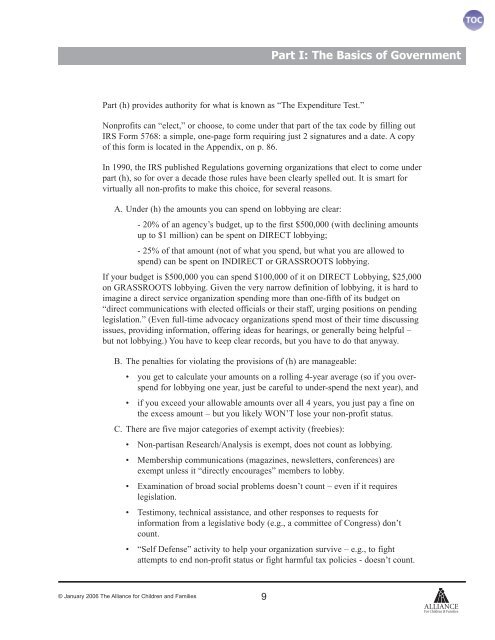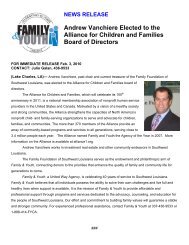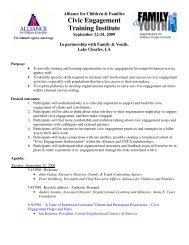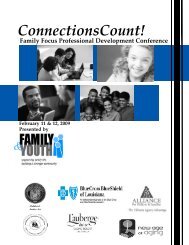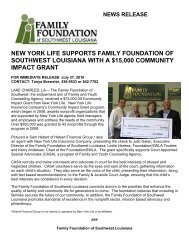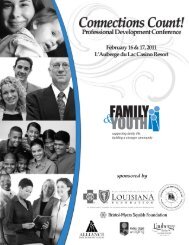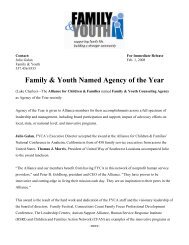Mission-based Advocacy Toolkit from Alliance for Children & Families
Mission-based Advocacy Toolkit from Alliance for Children & Families
Mission-based Advocacy Toolkit from Alliance for Children & Families
Create successful ePaper yourself
Turn your PDF publications into a flip-book with our unique Google optimized e-Paper software.
Part (h) provides authority <strong>for</strong> what is known as “The Expenditure Test.”<br />
© January 2006 The <strong>Alliance</strong> <strong>for</strong> <strong>Children</strong> and <strong>Families</strong> 9<br />
Part I: The Basics of Government<br />
Nonprofits can “elect,” or choose, to come under that part of the tax code by filling out<br />
IRS Form 5768: a simple, one-page <strong>for</strong>m requiring just 2 signatures and a date. A copy<br />
of this <strong>for</strong>m is located in the Appendix, on p. 86.<br />
In 1990, the IRS published Regulations governing organizations that elect to come under<br />
part (h), so <strong>for</strong> over a decade those rules have been clearly spelled out. It is smart <strong>for</strong><br />
virtually all non-profits to make this choice, <strong>for</strong> several reasons.<br />
A. Under (h) the amounts you can spend on lobbying are clear:<br />
- 20% of an agency’s budget, up to the first $500,000 (with declining amounts<br />
up to $1 million) can be spent on DIRECT lobbying;<br />
- 25% of that amount (not of what you spend, but what you are allowed to<br />
spend) can be spent on INDIRECT or GRASSROOTS lobbying.<br />
If your budget is $500,000 you can spend $100,000 of it on DIRECT Lobbying, $25,000<br />
on GRASSROOTS lobbying. Given the very narrow definition of lobbying, it is hard to<br />
imagine a direct service organization spending more than one-fifth of its budget on<br />
“direct communications with elected officials or their staff, urging positions on pending<br />
legislation.” (Even full-time advocacy organizations spend most of their time discussing<br />
issues, providing in<strong>for</strong>mation, offering ideas <strong>for</strong> hearings, or generally being helpful –<br />
but not lobbying.) You have to keep clear records, but you have to do that anyway.<br />
B. The penalties <strong>for</strong> violating the provisions of (h) are manageable:<br />
• you get to calculate your amounts on a rolling 4-year average (so if you overspend<br />
<strong>for</strong> lobbying one year, just be careful to under-spend the next year), and<br />
• if you exceed your allowable amounts over all 4 years, you just pay a fine on<br />
the excess amount – but you likely WON’T lose your non-profit status.<br />
C. There are five major categories of exempt activity (freebies):<br />
• Non-partisan Research/Analysis is exempt, does not count as lobbying.<br />
• Membership communications (magazines, newsletters, conferences) are<br />
exempt unless it “directly encourages” members to lobby.<br />
• Examination of broad social problems doesn’t count – even if it requires<br />
legislation.<br />
• Testimony, technical assistance, and other responses to requests <strong>for</strong><br />
in<strong>for</strong>mation <strong>from</strong> a legislative body (e.g., a committee of Congress) don’t<br />
count.<br />
• “Self Defense” activity to help your organization survive – e.g., to fight<br />
attempts to end non-profit status or fight harmful tax policies - doesn’t count.


